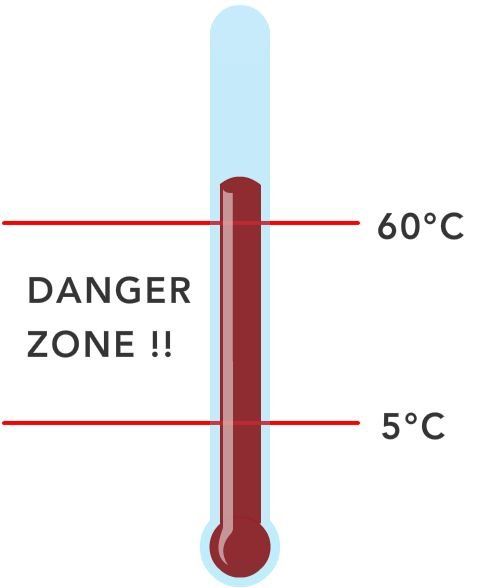Food Safety
Basic Knowledge
Every day people all over the world get sick from the food they eat. This sickness is called foodborne disease and is caused by dangerous microorganisms and/or toxic chemicals.
Most foodborne disease is preventable with proper food handling.
Microorganisms are very small living things, so small that they cannot be seen with the naked eye. There are three different types of microorganisms: the good, the bad and the dangerous.
Good microorganisms are useful. They contribute to:
make food: e.g. cheese, wine, beer, bread, ...
make medicine: e.g. peniciline
help digest food in the gut
Bad microorganisms, or spoilage microorganisms, do not usually make people sick, but they cause our food to smell bad, taste horrible and look disgusting. Dangerous microorganisms make people sick and can even kill. These are called "pathogens". Most of these microorganisms do not change the appearance of the food.
Microorganisms are so small that it takes 1 million to cover the head of a pin. Bacteria, viruses, yeasts, moulds and parasites are all microorganisms.
The smell, taste and appearance of food are not good indicators of whether the food will make you sick. Some spoilage microorganisms do change the appearance of food and are dangerous. An example is the green mould on bread which can produce toxins. Examples of common dangerous foodborne microorganisms include:
Bacteria - Salmonella, Shigella, Campylobacter and E. coli
Parasites - Giardia, Trichinella
Viruses Hepatitis A, Norovirus
Where do microorganisms live?
Microorganisms are everywhere, but are mostly found in:
o Faeces
o Soil and water
o Rats, mice, insects and pests
o Domestic, marine and farm animals
o People (bowel, mouth, nose, intestines, hands, fingernails and skin)
How do microorganisms grow?
Most microorganisms "grow" by multiplication. To multiply, microorganisms need:
o Food
o Water
o Time
o Warmth
Meat, seafood, cooked rice, cooked pasta, milk, cheese and eggs are foods that provide ideal
conditions for microorganisms to grow.
What are the symptoms of foodborne disease?
The most common symptoms of foodborne disease are:
o Stomach pains
o Vomiting
o Diarrhea
The symptoms depend on the cause of the disease. Symptoms may occur very quickly after eating the food, or may take days or even weeks to appear. For most foodborne diseases, symptoms occur 24 -72 hours after the food has been eaten. Foodborne disease can lead to long-term health problems. Very severe diseases, including cancer, arthritis and neurological disorders can be caused by contaminated food.
What to do if you get sick?
Notify the master.
What about chemicals?
Microorganisms are not the only cause of foodborne illness. People also get sick from poisonous chemicals, which include:
o Natural toxins
o Metals and environmental pollutants
o Chemicals used for treating animals
o Improperly used pesticides
o Chemicals used for cleaning
o Improperly used food additives
Simple measures such as washing and peeling may reduce the risk from chemicals that are found on the surface of foods. Appropriate storage can avoid or reduce the formation of some natural toxins.
In all of this you can make a difference by following
The Five Keys to Safer Food:
1. Keep clean
2. Separate raw and cooked
3. Cook thoroughly
4. Keep food at safe temperatures
5. Use safe water and raw materials
a
Keep clean
Core information:
Wash your hands before handling food and often during food preparation
Wash your hands after going to the toilet
Wash and sanitize all surfaces and equipment used for food preparation
Protect kitchen areas and food from insects, pests and other animals
Why?
While most microorganisms do not cause disease, dangerous microorganisms are widely found in soil, water, animals and people. These microorganisms are carried on hands, wiping cloths and utensils, especially cutting boards, and the slightest contact can transfer them to food and cause foodborne diseases.
How to keep yourself clean:
Hand-washing
Hands frequently transport microorganisms from one place to another, so hand-washing is very important.
You should wash your hands:
Before handling food and often during food
Before eating
After going to the toilet
After handling raw meat or poultry
After blowing your nose
After handling rubbish
After handling chemicals (including those used to clean)
After smoking
To wash your hands you should:
o Wet hand under running water
o Rub hands together for at least 20 seconds with soap
o Rinse your hands under running water
o Dry hands thoroughly with a clean dry towel, preferably a paper towel
How to clean plates and utensils
In general, one should:
Clean while preparing food, so microorganisms do not have a chance to grow
Pay special attention to eating, drinking and cooking utensils that raw food or the mouth
Sanitize cutting boards and utensils after they have been in contact with raw meat or seafood
Don’t forget to clean and dry the cleaning equipment, as microorganism grow fast in damp places
For cleaning after the meal, one should:
Scrape excess food into a rubbish bin
Wash in hot water with detergent, using a clean cloth or brush to remove left-over food or grease
Rinse in clean hot water
Sanitize utensils with boiling water or with a sanitizing solution
Leave dishes and cooking utensils to air-dry, or wipe with a clean dry cloth
How to protect food preparation areas from pests
Pests are rats, mice, birds, cockroaches, flies and other insects. Pet animals (dogs, cats, birds, etc.) carry microorganisms and pests (fleas, ticks, etc.) on their feet, fur and feathers.
To keep food safe from pests, one should:
Keep food covered or in closed containers
Keep rubbish bins covered and remove the rubbish regularly
Keep food preparation areas in good condition (repair wall cracks or holes)
Use baits or insecticides to kill pests (taking care not to contaminate food)
Separate raw meat, poultry and seafood from other foods
Use separate equipment and utensils such as knives and cutting boards for handling raw foods
Store food in containers to avoid contact between raw and prepared foods
Why?
Raw food, especially meat, poultry and seafood and their juices, can contain dangerous microorganisms which may be transferred onto other foods during food preparation and storage.
o Keeping raw and prepared food separate prevents the transfer of microorganisms.
o “Cross-contamination” is a term used to describe the transfer of microorganisms from raw to cooked food.
How to keep raw and prepared food separate:
While shopping, keep raw meat, poultry and seafood separate from other foods.
In the refrigerator, store raw meat, seafood and poultry below cooked or ready to eat foods to avoid cross-contamination.
Store food in containers with lids to avoid contact between raw and prepared foods.
Wash plates used for raw food. Use a clean plate for cooked foods
Cook thoroughly
Core information:
Cook food thoroughly, especially meat, poultry, eggs and seafood
Bring foods like soups and stews to boiling point to make sure that they have reached 75°C. For meat and poultry, make sure that juices are clear, not pink. Ideally, use a thermometer.
Reheat cooked food thoroughly
Why?
Proper cooking can kill almost all dangerous microorganisms. Studies have shown that cooking food to a temperature of 75°C can help ensure it is safe for consumption. Foods that require special attention include minced meats, rolled roasts, large joints of meat and whole poultry.
How to cook safely in a microwave oven:
Microwave ovens can cook unevenly and leave cold spots where dangerous bacteria can survive. Make sure that food cooked in a microwave oven is at a safe temperature throughout.
Some plastic containers release toxic chemicals upon heating and should not be used in the microwave to heat food.
How to cook food thoroughly
Food must reach a temperature of 75°C in order to ensure it is safe to eat. A temperature of 75°C kills even high concentrations of microorganisms within 30 seconds. Use a thermometer to check that foods reach 75°C. Some audiences will need to be taught how to use a thermometer. Instructions for use are the following:
o Place the thermometer in the centre of the thickest part of the meat.
o Make sure the thermometer is not touching a bone or the side of the container.
o Make sure the thermometer is always cleaned and sanitized to avoid cross-contamination between raw and cooked meat.
If a thermometer is not available:
Cook poultry until the juices are clear and the inside is no longer pink
Cook eggs and seafood until piping hot throughout
Bring liquid bases foods such as soups and stews to a boil and continue to boil for at least 1 minute.
Additional Information
The centre of an intact piece of meat is often sterile. Most bacteria are in the outer surface. Eating intact pieces of meat (e.g. roast beef) with red centers is usually not dangerous. However, in minced meat, rolled roasts or poultry, bacteria can be found both outside and in the centre.
Lower cooking temperatures can be used to kill microorganisms in certain foods. With lower temperatures, more cooking time is required.
Reheat cooked food until is piping hot throughout
Keep food at safe temperatures
Core information:
Do not leave cooked food at room temperature for more than 2 hours
Refrigerate promptly all cooked and perishable food (preferably below 5°C)
Keep cooked food piping hot (more than 75°C) prior to serving
Do not store food long even in the refrigerator
Do not thaw frozen food at room temperature
Why?
Microorganisms can multiply very quickly if food is stored at room temperature. By holding at temperatures
below 5°C or
above 60°C, the growth of microorganisms is slowed down or stopped. Some dangerous microorganisms still grow below 5°C.
Thawing Food Safely in the Microwave
Microwave ovens can be used to thaw food, but can leave warm spots where microorganisms can grow. Food thawed in the microwave oven should be cooked promptly.
What are safe temperatures for food?
The danger zone is the temperature range of 5°C to 60°C in which microorganisms multiply very fast.
Refrigeration slows bacterial growth. However, even when food is stored in the refrigerator or freezer, microorganisms can grow.
How to keep food at safe temperature:
Promptly cool and store leftovers.
Prepare food in small amounts to reduce the amount of leftovers.
Leftover food should not be stored in the refrigerator for longer than 3 days and should not be reheated more than once.
Thaw food in the refrigerator or other cool location
Use safe water and raw materials
Core information:
Use safe water or threat it to make it safe
Select fresh and wholesome food.
Wash fruits and vegetables, especially if eaten raw
Do not use food beyond its expiry date
Why?
Raw materials, including water and ice, may be contaminated with dangerous microorganisms and chemicals. Toxic chemicals may be formed in damaged and mouldy foods. Care in selection of raw materials and simple measures such as washing and peeling may reduce risk.
What is safe water?
“Safe” means that water is free from dangerous microorganisms and toxic chemicals at levels that could cause illness and/or disease.
Safe water is needed to:
Wash fruits and vegetables
Add to food
Make up drinks
Make ice
Clean cooking and eating utensils
Wash hands
How to keep raw materials safe:
Avoid food that is damaged or rotting
Wash fruits and vegetables with safe water, especially if eaten raw
Do not use food after its expiry date
Throw away smashed, swollen of oxidized cans
Additional Information
- Boiling, chlorination and filtration are important means to inactivate microbial pathogens, but do not remove harmful chemicals.
- Bacteria can grow in can goods that are not properly prepared.
- Fresh fruit and vegetables have been identified as a significant source of pathogens and chemical contaminants. Therefor it is critical to wash all fruits and vegetables before eating.
- Cut away damaged or bruised areas of fruits or vegetables – bacteria can thrive in those places.
- Pay attention to the expiry date on food items and throw away food when the date has passed.
Food safety in practice
What should you remember when accepting stores:
- Check use-by date.
- Check surface temperature for refrigerated and frozen goods.
- All chilled goods should be refrigerated/frozen as quickly as possible.
- The temperature of refrigerated products must not exceed 8° C .
- On delivery and receipt, the temperature of frozen goods must not be higher than-12° C.
- If the packaging is punctured, it must be rejected.
- Move the oldest products to the front of shelves and put the new ones at the back.
- Keep dry goods in good order and put them all on shelves. The distance between the bottom shelf and deck must be mm. 15 cm.
What should you remember when storing dry, refrigerated and frozen food:
- Refrigerate perishable food at max. 5°C
- Store frozen goods at -18°C or less.
- The ideal temperature for keeping dry stores 10-20°C.
- Fruit and vegetables have various ideal storage temperatures. Check the chart in Annex to this manual.
What must you remember when preparing hot food and placing it on the buffet:
- Hot food must always be heated to a core temperature of 75°C and be piping hot.
- Stir hot dishes to provide an even temperature throughout.
- Check the temperature with a roasting thermometer.
- Never heat food in packaging that is not approved for microwaving.
- Keep hot dishes in the buffet at least at 65°C.
- Three hours is the maximum time from preparing hot food for the buffet until it is back in the refrigerator.
- Leftovers must only be used once and those that have stood on the table for more than three hours must never be used in new dishes.
- Leftovers can only be used when reheated to 75°C.
What are the most important things to remember when chilling and defrosting food:
- Hot food must be cooled from 65°C to 10°C in less than three hours.
- Place food in the refrigerator if you are interrupted or are preparing food in advance, if you plan to use it later when cooking
- Three hours is the maximum time from taking cold food from the refrigerator for the buffet, until it is back in the refrigerator.
- Frozen meat, processed meat and meat products can not be thawed more than ones. Defrosted food can not be stored in the freezer again for reuse.
- Always chill hot food e.g. on oven trays or divide into smaller portions to make the surface as great as possible. Food then cools faster.
- Place leftovers on the night tray in the refrigerator and cover with microwave film.
- Always defrost food products in the refrigerator and keep them separate.
- Always defrost meat at the bottom of the refrigerator, so that juices do not drip onto other food.
Good work routines ensure safe food hygiene:
- Always wash your hands before you start and remove jewellery.
- Only use clean work clothing, cloths and tea towels. Wherever possible, use paper instead of cloths and food-grade gloves as required.
- Always wash hands when switching from one raw ingredient to another.
- Always keep raw ingredients separate when preparing and cooking your dishes.
- Always use clean chopping boards and knives, preferably in different colours.
- Keep your work table in the galley tidy.
- Clean with hot water and disinfectant.
- Comply with the ship’s self-assessment/cleaning plans and have a plan for using leftovers and procedures for disposal of waste.
- Keep written documentation and menu plans.











